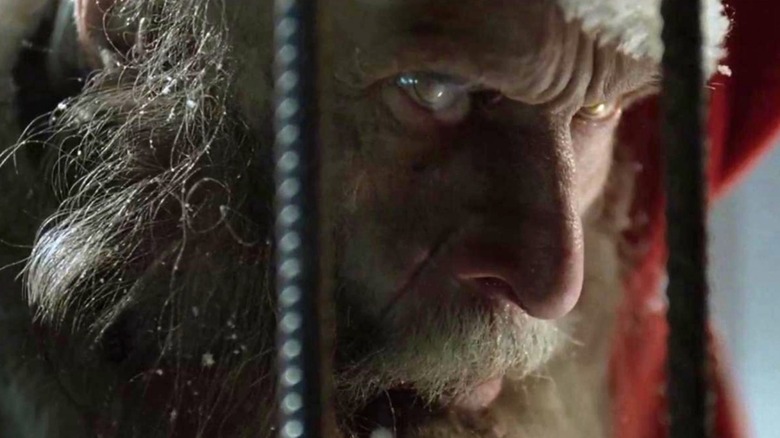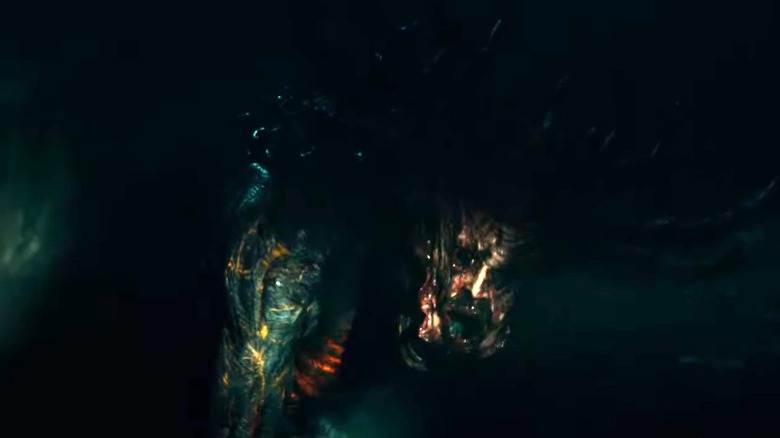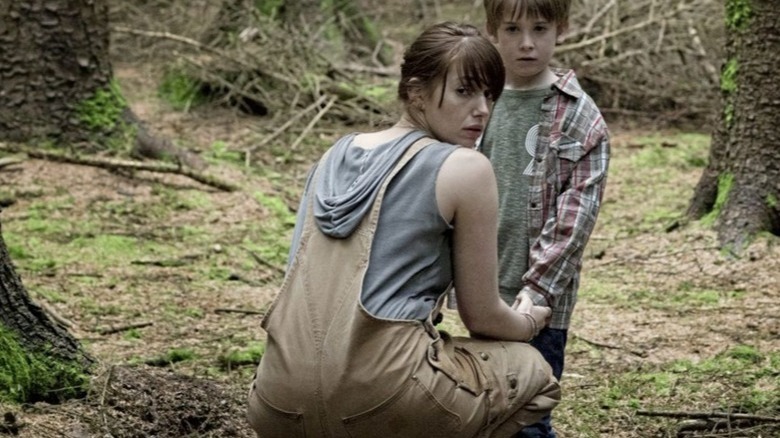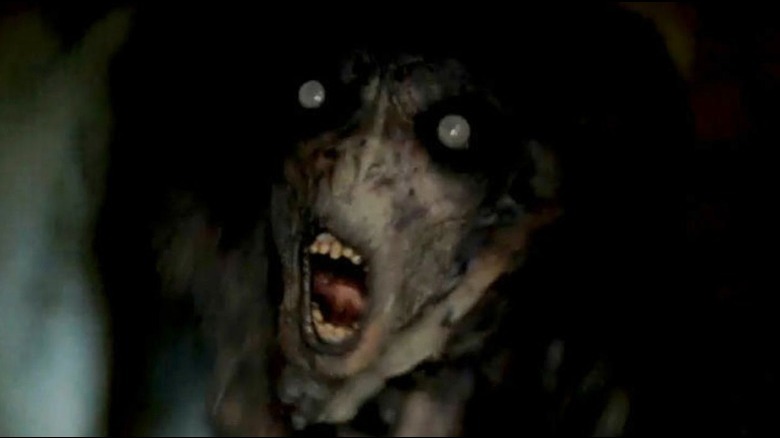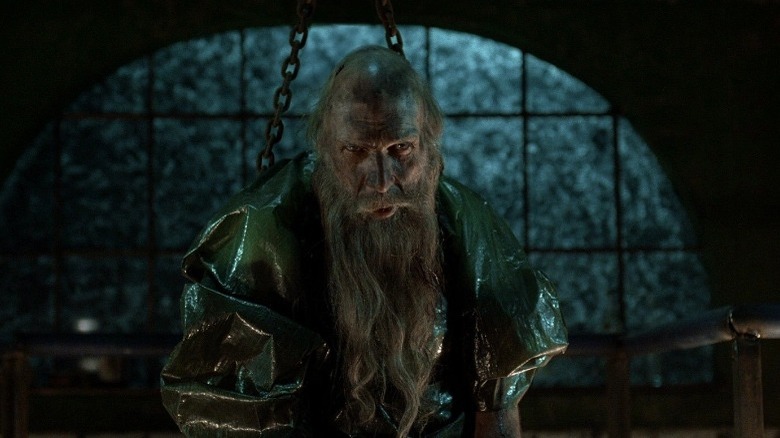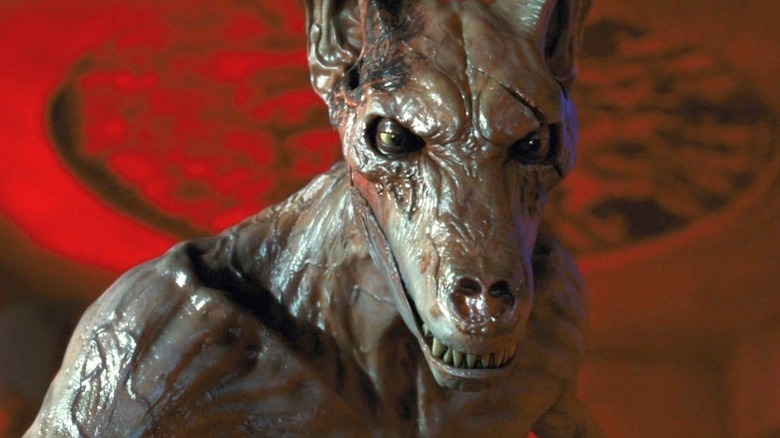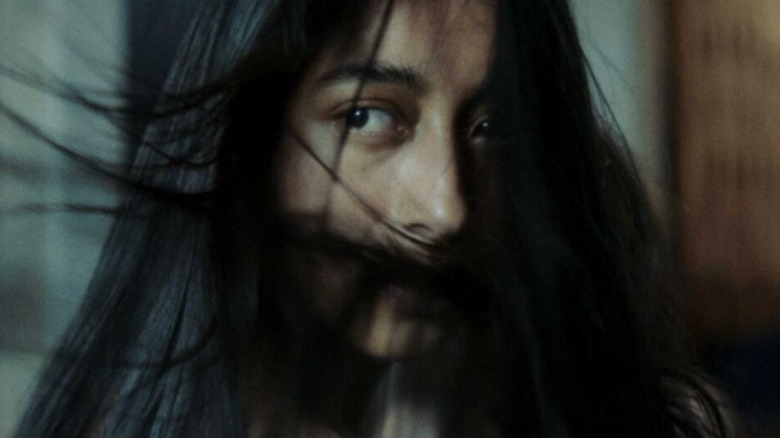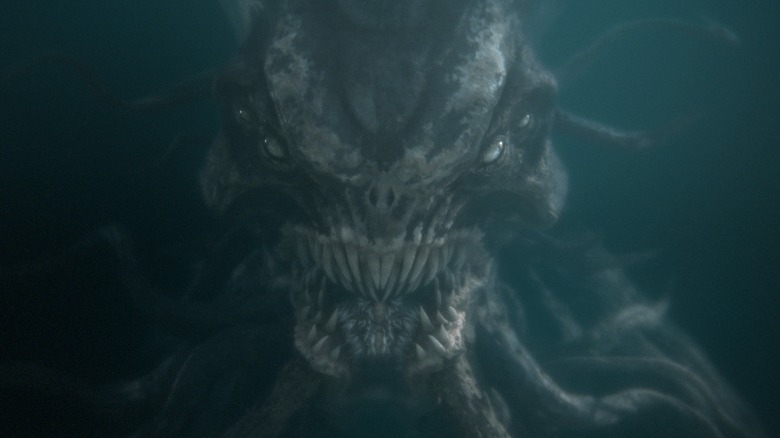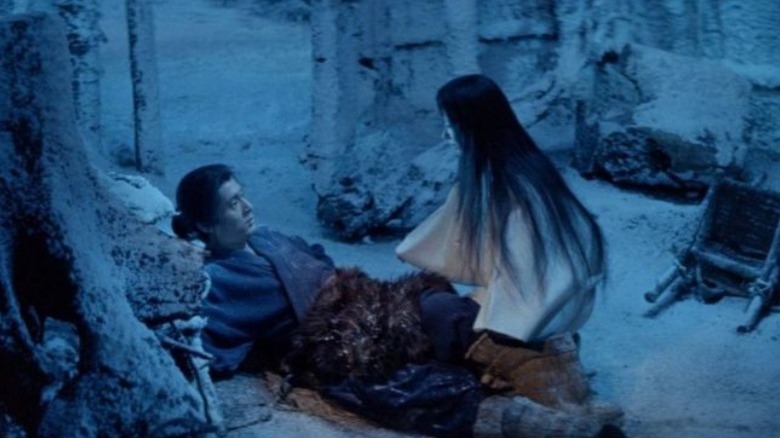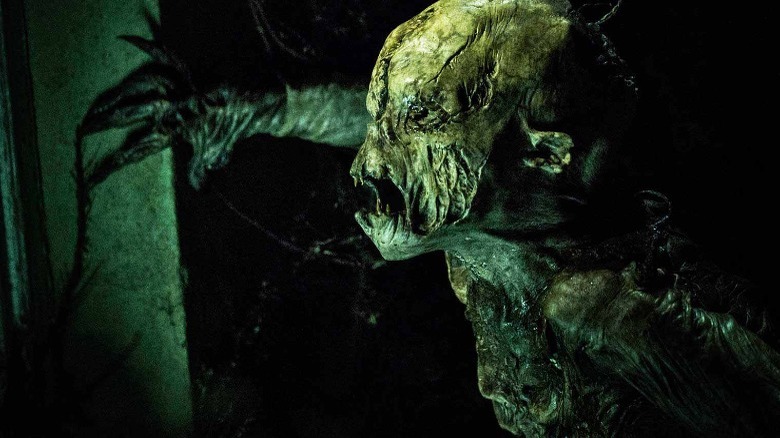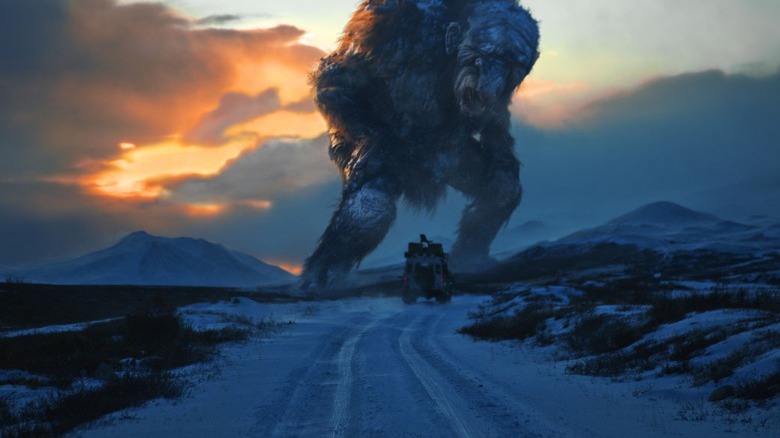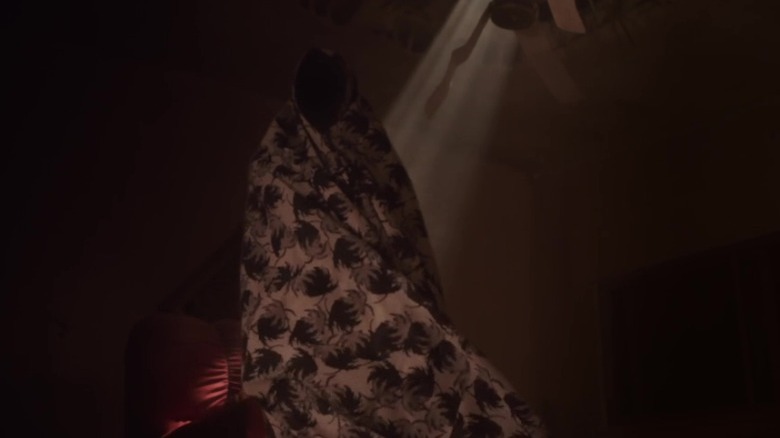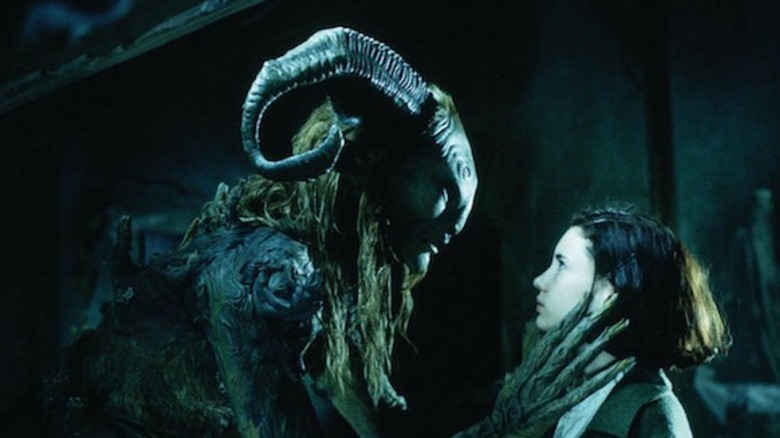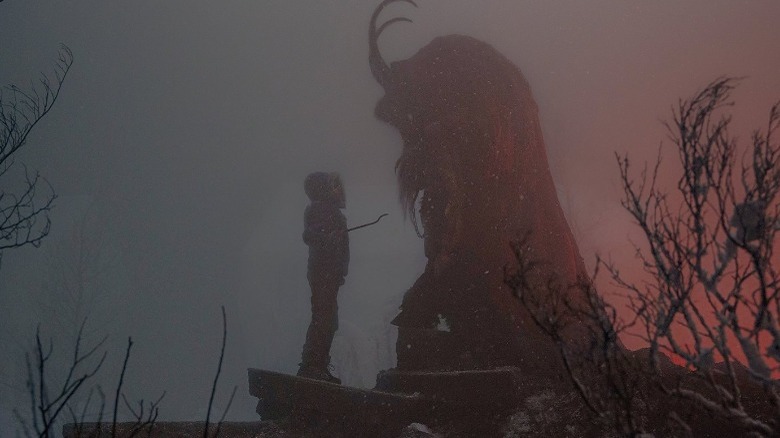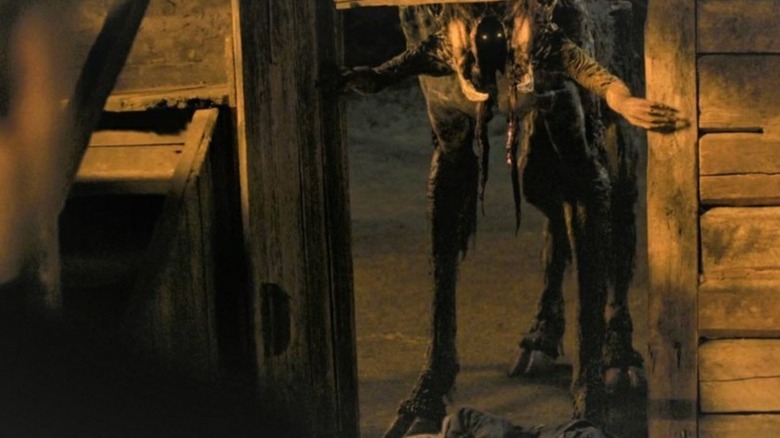The 14 Scariest Mythological Monsters In Horror Movies
Movie monsters are mythic in their own right. The tales of Michael Myers and Pennywise the Clown are no different, both in form and narrative structure, than the legends of yore. They are modern parallels to Medusa and Hades, mythic monsters with penchants for death and destruction. Horror movies in particular are defined by their monsters. Decades of "Halloween" sequels prove as much; even when the movie flounders, the monster endures.
While new monsters are stellar, it's always exceptionally exciting to see a new medium repurpose old beasties. As such, the monsters on this list are all grounded in myth, folklore, fable, or religion in some capacity. This list isn't exhaustive — sorry, fans of Syfy's "Chupacabra: Dark Seas" — but rather, it represents some of the best modern takes on mythological creatures that cinema has to offer. These monsters existed long before cinema; given their stature, they'll likely be around long after, too.
The Wendigo in Antlers
Scott Cooper's "Antlers" is the most recent movie on this list. The Wendigo isn't new to cinema (see: "Wendigo," "Dark Was the Night," or even video games like "Until Dawn"), though it has never been as gloriously realized as it was in Cooper's Pacific Northwest creeper. Keri Russel stars as Julia Meadows, a schoolteacher who, despite grappling with her own latent trauma, takes an interest in student Lucas Weaver (Jeremy T. Thomas). She suspects that Lucas is being abused by her father, though what she discovers is considerably more terrifying than she could have imagined.
See, both Lucas' father and brother are Wendigos. Cooper goes to great lengths to ground the Wendigo myth in its original form: a cannibalistic Native American spirit that jumps from person to person, perennially hungry. Largely hidden in the shadows, Cooper wisely shows the beast in all its glorious, practical might. Gory, gooey, and wearing the fleshy face of its most recent victim, it's nightmare-inducing. It'll be a long while before the Wendigo looks this good again.
The Changeling in The Hole in the Ground
A24 did not do well by "The Hole in the Ground." Sure, it's no "The Witch" or "Hereditary," but it's still a "supremely scary" horror movie that, with the right backing, could have been part of the discussion alongside the company's most noteworthy horror efforts. With a solid grasp on maternal anxiety and perennial Irish fear, it's brooding, distinct, and scary as hell.
"The Hole in the Ground" stars Seána Kerslake as Sarah O'Neill, a single mother who moves to the Irish countryside with her son, Christopher (James Quinn Markey), in a bid to escape Chris' father. There, she and Chris both stumble across the titular hole in the ground, and after Chris wanders from the house one night, Sarah suspects that what returns may not be her son.
She's right. Chris is now a changeling. A popular legend throughout most of Europe, a changeling is believed to be a fairy left in place of human children. They generally make the swap to cause mischief and mayhem, and, as in Chris' case, sometimes arrive with homicidal intentions. A clear allegory for the impact that Sarah's abusive ex may have had on Chris' psyche — Sarah fears that he's destined to be no different — the myth is still adroitly reviewed and terrifyingly rendered. You'll be questioning the identities of your own children for weeks to come.
Fairies in Don't Be Afraid of the Dark
As a producer, Guillermo del Toro has a clear proclivity for the kinds of projects he chooses to back. He wants childhood trauma and lush, grand, Gothic settings. He wants myth and folklore. He wants subversive fairy tales (sometimes quite literally) rendered with contemporary gusto, fueled by the demands of modern horror. As such, director Troy Nixey's "Don't Be Afraid of the Dark" is a lush and cruel remake of ABC's 1973 made-for-TV movie of the same name. While the original is a camp classic in its own right — I mean, it has Kim Darby being menaced by little gremlins — Nixey's remake is more in line with del Toro's work. That's hardly a surprise; he's credited as a co-writer.
A sensational Bailee Madison stars as Sally Hurst, a young girl resigned to living with her oblivious father (Guy Pearce) at the isolated Blackwood Manor after her mother loses interest in parenting. At the lush Gothic estate, Sally soon invites the attention of creatures living in the cellar, which are soon revealed to be fairies living deep within the earth.
Fairy myths go back generations, with some texts depicting them as angels or demons. One recurring motif is the need to ward them off, as well as their desire to steal from the living. While the origins of the fairies in "Don't Be Afraid of the Dark" remain unclear, they seem to have connections to changeling myths (the film also makes some allusions to the tooth fairy). With creatures like this on the prowl, you'll be afraid of the dark, guaranteed.
Joulupukki in Rare Exports: A Christmas Tale
Santa Claus is conventionally depicted as a jolly, happy fellow. Some (read: Megyn Kelly) are almost pathologically compelled to defend his mythos and all of the traditional trappings. Not the people behind Finnish horror-comedy "Rare Exports," though. Exceptionally conceived by writer-director Jalmari Helander, "Rare Exports" follows Onni Tommila as Pietari Kontio, a young boy embroiled in the middle of an excavation of Joulupukki, the Finnish folkloric figure responsible for modern day conceptions of Santa Claus.
Unlike jovial Saint Nick, Joulupukki is said to be a monstrous, horned beast, one who whips bad children and boils them in a coffin. The "Rare Exports'" rendition is little more than an emaciated shell of what he once was, though his legion of homicidal elves proves to be a considerable match for the unlucky residents of Korvatunturi, the poor saps targeted by dint of mere proximity. A bloody good time, "Rare Exports" is one of the most distinct Christmas horror movies ever made, and it has an exceptional monster at its center.
Anubis in The Pyramid
For the first two-thirds of its runtime, "The Pyramid" isn't, strictly speaking, a good movie. Despite having French horror auteur Alexandre Aja as a credited producer, "The Pyramid" is curiously sparse. The acting is iffy, the setting is cheap, and the scares are reduced to "loud noises." As directed by Grégory Levasseur in his feature debut, it's an intermittently bottom-of-the-barrel found footage film, the kind of movie indicative of a dying trend.
Something curious happens in the third act, though. When the main antagonist is introduced, "The Pyramid" becomes a hoot. An archeological team discovers a lost pyramid in Egypt and immediately straps on some gear to explore it. They're picked off one after another by an unseen creature. By the end, only Ashley Hinshaw's Dr. Nora Holden remains. Then, in a ritualistic chamber, the unseen antagonist finally makes himself known.
It's none other than Anubis, the Egyptian god of death, mummification, embalming, and the afterlife. He is featured in all his jackal-like glory with his weighing scale, a tool whereby the hearts of the deceased are measured to judge their worth. Visually, he's little more than another scary monster in the dark, but it's a ridiculous twist that works. There's something terrifically camp about seeing an Egyptian God just traipsing about a hidden temple in 2015.
La Llorona in La Llorona
La Llorona, also known as "the Weeping Woman," is a central figure in Mexican folklore. Though early texts identify her as a pre-Hispanic figure, her story involves an indigenous woman who drowns her two children in a river after their father, often conceptualized as a wealthy Spaniard or a conquistador, abandons her. She then drowns herself, but finds herself unable to enter the afterlife, and is doomed to roam the riverside in search of her children.
The myth has been adapted frequently as of late, including into a standalone entry in "The Conjuring" cinematic universe, but the best modern incarnation is found in Jayro Bustamante's Guatemalan horror film, aptly titled "La Llorona." Replete with political trauma, the movie involves a Guatemalan dictator and his family, locked away in their country home while patriarch and former ruler Enrique Monteverde (Julio Diaz) is on trial for genocide. As the days move on, several family members report sightings of a weeping woman.
The scares only arrive in earnest in the film's final few minutes, and those wary of slow-burn horror won't find a lot that works here. But for those with patience, "La Llorona" is a tremendously frightening foray into generational trauma with a sensational specter at its center.
Cthulhu in Underwater
"Underwater" is a lot like "The Pyramid." As directed by William Eubank and written by both Brian Duffield and Adam Cozad, it's certainly better scripted and crafted, and it's got a brooding Kristen Stewart as its lead, but its core identity still doesn't make itself known until late into the film.
Stewart is one of several workers at an underwater drilling facility who are forced to leave after an earthquake threatens the stability of their quarters. In their desperate bid to escape, they discover that something is hunting them, picking them off one by one. Of course, in the third act, these antagonists are revealed to be Cthulhu and the Deep Ones, central figures in H.P. Lovecraft's Cthulhu mythos.
A form of contemporary mythopoeia — myths that originate in a fictional, literary universe — Cthulhu is no less identifiable than the fairies or banshees of yore. Lovecraft's works have had a profound impact on the horror genre writ large, and it speaks to Cthulhu's perennial recognition that a mid-tier studio genre feature used him as the central antagonist. "Underwater," at the end, amounts to Kristen Stewart versus Cthulhu. It doesn't get better than that.
The Yuki-Onna in Kwaidan
"Kwaidan" is a classic. One of the best horror anthologies ever made, Masaki Kobayashi's dense masterpiece is a long, stylish, and cinematically dazzling foray into Japanese folktales, most of which were adapted from "Kwaidan: Stories and Studies of Strange Things," a 1904 collection of Japanese ghost stories. With four unrelated stories, "Kwaidan" won both the Special Jury Prize at the 1965 Cannes Film Festival and a nomination for best foreign language film at the Academy Awards.
"The Woman of the Snow" segment adapts a yuki-onna myth. The yuki-onna are a class of Yōkai, or spirits in Japanese folklore, who look like beautiful women and visit and marry men. In one tale, the husband forces his wife to take a bath, and when she does, she disappears into a flurry of icicles (yuki-onna roughly translates to "snow woman").
"The Woman of the Snow" retells another classic story. It follows a woodcutter spared from the yuki-onna's wrath after he and a friend seek shelter in a hut during a terrible snowstorm. He is told to never mention it again, lest he be killed. Years later, he marries a beautiful woman who, yes, is the yuki-onna. They remain married for years and have several children together. When he finally tells her the tale, she assumes her true form, though she refrains from killing him on account of their life together. However, she threatens to return if he does wrong by their children. It's tender, haunting, and even a little romantic.
Fairies in The Hallow
Fairies are back, baby. Corin Hardy summoned some of the nastiest little buggers from Irish folklore, and all he got in return was the chance to direct "The Nun." Ouch. In all seriousness, though, "The Hallow" is a tense, evocative, genuinely frightening, and criminally underseen creature feature rooted in rural folklore. The effects are stellar, the scares effective, and the homages to del Toro among the best the genre has seen in some time.
Adam Hitchens (Joseph Mawle) is a conservationist who moves to a remote Irish village with his wife, Claire (Bojana Novakovic) and their young son, Finn. The locals aren't too happy they've moved in, and as Adam scours the nearby woods for fungal samples, he encounters several curious sights, including animal carcasses covered in strange substances. Soon, the legend of "The Hallow" is revealed. They are fairies, banshees — female fairies who herald the death of a loved one by wailing — and changelings, and they have plans to steal baby Finn.
Never constrained by the film's low budget, the creatures in "The Hallow" look excellent, and the script wickedly subverts several "couple moves to a town where they're unwanted" tropes. It's a sensational genre outing with some truly vicious fairies at its center.
Trolls in Troll Hunter
Writer-director André Øvredal simply doesn't get enough credit. Despite having works like "Troll Hunter," "Scary Stories to Tell in the Dark," and "The Autopsy of Jane Doe" to his name, he is curiously absent from most conversations about contemporary horror maestros. It's a shame, especially in the case of "Troll Hunter," one of the most exhilarating and wildly inventive found footage movies from this century.
Students from Volda University College seek to film a documentary about Hans (Otto Jespersen), a notorious bear poacher, but when they secretly follow him into the woods one night, they discover what he's really hunting: trolls. In Norse mythology, trolls are described as monstrous beings who dwell in isolated caves, forming small family units while being generally hostile to humankind. They're often said to be both ugly and colossal.
The trolls in Øvredal's film are no different. They appear in the distance, towering over the characters. When they need to, they flip over vehicles and chase down jeeps. They're terrifyingly and gorgeously rendered, and the found footage conceit keeps them frightening without ever shattering the illusion. "Trollhunter" is a hoot and a half, a pure adrenaline rush of mythic monsters and blockbuster action.
The Djinn in Under the Shadow
"Under the Shadow" is another myth-centric horror movie that, unfortunately, never got the credit it deserved. Like "Antlers," it inserts an ancient monster into a deeply socio-political text, using a distinct cultural context to augment its central menace. Babak Anvari's Persian-language directorial debut follows Shideh (Narges Rashidi), a mother and former medical student living in post-revolutionary Tehran. Unallowed to continue her studies because of her political affiliations, she stays in the city with her daughter, Dorsa (Avin Manshadi), despite the objections of her husband, who has been consigned into military service.
After new neighbors move in, a missile crashes into the building, and all manner of spooky goings-on are reported. Shideh is told the legend of the Djinn, spirits in Islamic mythology that, while sometimes benevolent, are often said to be responsible for misfortune and death. Anvari uses the myths to maximum effect, delivering searing social commentary on womanhood in Tehran while delivering the expected supernatural scares. There are several noteworthy jolts, and the ending is all out Djinn-tastic. "Under the Shadow" is the rare political horror film that delivers both commentary and scares in equal measure. It's simply sensational.
The Faun in Pan's Labyrinth
After many films inspired by and alluding to Guillermo del Toro, we've finally reached an entry from the master of modern myth himself. Despite having titles such as "Cronos," "Mimic," and "The Devil's Backbone" on his filmography, del Toro's legacy was truly cemented with "Pan's Labyrinth," which is arguably still his most profound achievement. A fairy tale that borrows thematically from his preceding output, it's del Toro at his peak, a horror-fantasy hybrid that remains inimitable.
The prologue outlines the tale of Princess Moana, a young girl whose father is king of the underworld. When she visits the human world, the light blinds her and she dies, so her father builds several labyrinthian portals, hoping they'll help her find her way home. Later, 10-year-old Ofelia (Ivana Baquero) is forced to move to the country with her ailing mother and stepfather, Captain Vidal (Sergi López), a general in Francoist Spain who hunts down Republican rebels. He's a cruel, callous man, and Ofelia wishes for nothing more than to escape. She is given the chance when she meets a faun (Doug Jones) in a stone labyrinth near the property.
Symbols of peace in Roman mythology, fauns are often conceptualized as half-goat, half-man. This faun believes Ofelia to be the spirit of Princess Moana, and gives her a book with three tasks she must complete before she can return. A tender and troubling examination of war, trauma, and escape, "Pan's Labyrinth" is the apotheosis of modern fairy tales.
Krampus in Krampus
Writer-director Michael Dougherty's "Krampus" had a lot to live up to. His long-delayed "Trick 'r Treat" had since become a cult classic — anyone who's visited a Spirit Halloween can attest that the movie's central antagonist, Sam, is the new de facto face of Halloween — and with "Krampus," audiences were eager to see whether lightning might strike twice. The cast looked great, with the likes of Toni Collette and Adam Scott leading the charge, and early promotional material promised something wickedly dark. Upon release, though, expectations were tempered. While critics called it "good, gory fun," "Krampus" never really took off.
That's a shame, because "Krampus" is incredible. The titular monster himself is incredibly realized, a practically rendered behemoth with massive tusks and a fur-lined robe, all wrapped in an assemblage of chains and bells. That image itself is worth the price of admission alone, though "Krampus" also delivers an exceptional modern take on an ancient myth.
Krampus, per Alpine folklore, was the anti-Santa Claus, a horned monster whose role was to scare misbehaving children during December, whipping them with birch rods for their misdeeds. "Krampus" respects his legend, turning Krampus into a genuinely unsettling presence summoned to punish a family that's lost its holiday spirit. With a league of monstrous toys and elves in tow, "Krampus" is uncompromising in its commitment to visceral, playful holiday terror.
Jötunn in "The Ritual"
Netflix often has a penchant for dropping new movies with little to no fanfare. Sometimes, these titles take off, securing a place in the top 10 for several weeks and cementing themselves as movies to remember. Other times, they evaporate as soon as they premiere. Lucky for "The Ritual," then, that it defied the odds, becoming one of Netflix's preeminent horror hits when it launched on the platform in 2018. With strong reviews and a terrifying central foe, it was subversive, unexpected, and defied expectations.
A group of four men hike the Kungsleden trail in northern Sweden to honor a friend who was killed in an attempt to thwart a robbery. The survivors are racked with guilt for their failure to intervene, and while it's bad enough that the surrounding woods incite hallucinations and ritualistic nightmares, it gets considerably worse when they discover a jötunn has been stalking them.
This jötunn is an ancient, god-like entity that descended from Loki; that's a twist, as mythology says that the jötunn are actually the Norse gods' early ancestors. A towering monster with an elk-like body, skeletal head, and human-esque hands, the jötunn is a terrifying foe, one the isolated cultists in "The Ritual" have been worshiping for generations.
